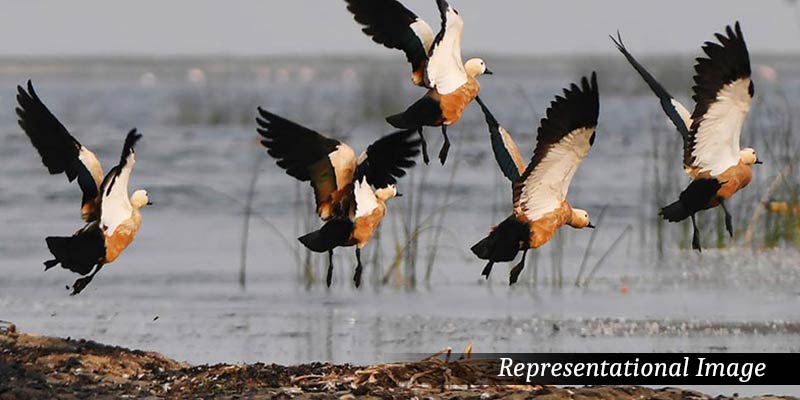- India
- Jan 31
5 more Indian wetlands added to Ramsar list
Five more Indian wetlands have been added to the global list of wetlands of international importance under the Ramsar Convention.
This takes the total number of such highly recognised waterlogged ecosystems in the country to 80.
Of the five new wetlands added to the Ramsar list, Magadi Kere Conservation Reserve, Ankasamudra Bird Conservation Reserve, and Aghanashini Estuary are in Karnataka and Karaivetti Bird Sanctuary and Longwood Shola Reserve Forest are in Tamil Nadu.
What is the Ramsar Convention?
• The Ramsar Convention is an international treaty signed by 172 countries to protect wetlands.
• It is named after the city in Iran where it was signed, and it began with 18 countries in 1971.
• The convention is one of the oldest inter-governmental accords for preserving the ecological character of wetlands. Also known as the Convention on Wetlands, it aims to develop a global network of wetlands for the conservation of biological diversity and for sustaining human life.
• It is one of the largest international agreements, after the Convention on Biological Diversity (CBD, 196 countries) and the UN climate agreement (UNFCCC, 197 countries).
• The Ramsar List is the world’s largest network of protected areas.
• There are over 2,400 Ramsar Sites around the world. The first Site was the Cobourg Peninsula in Australia, designated in 1974. The largest Sites are Rio Negro in Brazil (120,000 sq km), and Ngiri-Tumba-Maindombe in the Democratic Republic of Congo and Queen Maud Gulf in Canada. These Sites each cover over 60,000 sq km.
What are wetlands?
• Wetlands are ecosystems where water is the primary factor controlling the environment and the associated plant and animal life.
• Wetlands are land areas that are saturated or flooded with water either permanently or seasonally. Inland wetlands include marshes, ponds, lakes, fens, rivers, floodplains and swamps.
• Coastal wetlands include saltwater marshes, estuaries, mangroves, lagoons and even coral reefs. Fish ponds, rice paddies and saltpans are man-made wetlands.
• Wetlands provide a wide range of important resources and ecosystem services such as food, water, fibre, groundwater recharge, water purification, flood moderation, erosion control and climate regulation.
• They are, in fact, a major source of water and our main supply of freshwater comes from an array of wetlands which help soak rainfall and recharge groundwater.
• Though they cover only around 6 per cent of the Earth’s land surface, 40 per cent of all plant and animal species live or breed in wetlands.
• Wetland biodiversity matters for our health, our food supply, for tourism and for jobs. Wetlands are vital for humans, for other ecosystems and for our climate, providing essential ecosystem services such as water regulation, including flood control and water purification.
• More than a billion people across the world depend on wetlands for their livelihoods – that’s about one in eight people on Earth.
• Every year, February 2 is observed as World Wetlands Day to raise global awareness about the vital role of wetlands for our planet. This day also marks the date of the adoption of the Convention on Wetlands on February 2, 1971, in Ramsar, Iran.
Criteria for identifying Wetlands of International Importance
A wetland should be considered internationally important:
1) If it contains a representative, rare, or unique example of a natural or near-natural wetland type found within the appropriate biogeographic region.
2) If it supports vulnerable, endangered, or critically endangered species or threatened ecological communities.
3) If it supports populations of plant and/or animal species important for maintaining the biological diversity of a particular biogeographic region.
4) If it supports plant and/or animal species at a critical stage in their life cycles, or provides refuge during adverse conditions.
5) If it regularly supports 20,000 or more waterbirds.
6) If it regularly supports 1 per cent of the individuals in a population of one species or subspecies of waterbird.
7) If it supports a significant proportion of indigenous fish subspecies, species or families, life-history stages, species interactions and/or populations that are representative of wetland benefits and/or values and thereby contributes to global biological diversity.
8) If it is an important source of food for fishes, spawning ground, nursery and/or migration path on which fish stocks, either within the wetland or elsewhere, depend.
9) If it regularly supports 1 per cent of the individuals in a population of one species or subspecies of wetland-dependent non-avian animal species.
Additional read:
The vital role of wetlands for people and planet
Wetlands are ecosystems where water is the primary factor controlling the environment and the associated plant and animal life. Wetlands provide a wide range of important resources and ecosystem services such as food, water, fibre, groundwater recharge, water purification, flood moderation, erosion control and climate regulation.
Manorama Yearbook app is now available on Google Play Store and iOS App Store


